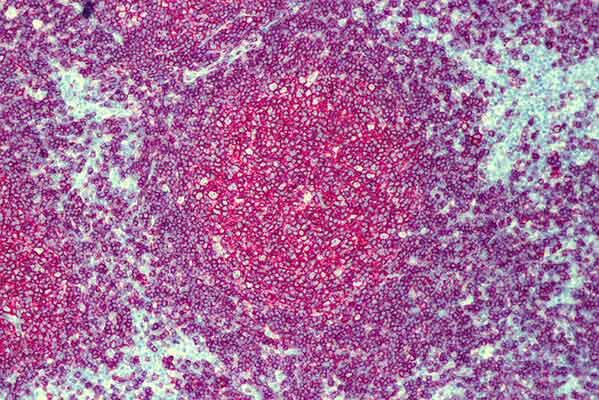New Rituximab Formulation Approved for Some Lymphomas, Leukemia
, by NCI Staff
On June 22, the Food and Drug Administration (FDA) approved a new formulation of the cancer drug rituximab (Rituxan™) that can be more easily administered to patients with several types of blood cancer.
The new formulation, called Rituxan Hycela, combines rituximab with the enzyme hyaluronidase, which allows it to be given to patients via injection in 5 to 7 minutes rather than through intravenous (IV) infusion, which can take up to several hours.
The new approval covers multiple indications previously approved for rituximab, including for follicular lymphoma (FL), diffuse large B-cell lymphoma (DLBCL), and chronic lymphocytic leukemia (CLL).
The approval stipulates that the subcutaneous treatment option can be used only after patients have received at least one treatment of rituximab through IV because there is a risk of hypersensitivity and other severe side effects during the first infusion.
In addition to being used to treat blood cancers, rituximab is approved for the treatment of some patients with rheumatoid arthritis or rare autoimmune diseases. FDA specified that the new combination is not indicated for the treatment of non-malignant diseases.
Multiple Trials Support Approval
Rituximab, a type of drug called a monoclonal antibody, works by binding to a protein known as CD20 on B cells, initiating an immune response against B cells and also directly killing them. Hyaluronidase is an enzyme that helps break down connective tissue to increase absorption of medications that are delivered under the skin.
FDA’s approval of the combination of the two drugs is based on results from several clinical trials that demonstrated that similar levels of rituximab were found in the blood after subcutaneous administration of the combination formulation and after IV administration of rituximab alone. Both forms of the drug had similar clinical efficacy and safety.
For example, in one phase III trial, 410 patients with previously untreated CD20-positive FL received either IV rituximab or subcutaneous rituximab with hyaluronidase. The overall response rate at the end of treatment was 84.9% in the IV group and 84.4% in the subcutaneous group. The frequency of severe side effects was similar as well: 34% of those in the IV group and 37% in the subcutaneous group. A phase III trial of patients with DLBCL also had similar results for efficacy and side effects in both treatment groups.
The most common side effects for patients in all of these studies who had the subcutaneous administration of rituximab included nausea, infections, and a low-white blood cell condition called neutropenia.
Faster Delivery
Approved indications for subcutaneous rituximab:
- As a single agent for relapsed or refractory FL
- For untreated FL in combination with first-line chemotherapy
- As a single-agent maintenance therapy for patients with FL whose cancers have responded to chemotherapy
- For non-progressing FL as a single agent after first-line chemotherapy
- For previously untreated DLBCL in combination with chemotherapy
- For previously untreated and treated CLL in combination with chemotherapy
Rituximab has been used in IV form for FL, DLBCL, and CLL for several years.
The new formulation definitely makes it easier to administer the drug, said Adrian Wiestner, M.D., Ph.D., a senior investigator who conducts a clinical research program for patients with CLL at the National Heart, Lung, and Blood Institute.
Several factors will influence the extent to which this new formulation is taken up in everyday care, including patient preference, Dr. Wiestner said.
“Subcutaneous rituximab cuts down on resource needs, so it could possibly cut down on travel times it takes patients to go to infusion centers because it could conceivably be done closer to home,” he continued. “It opens the door to providing the treatment in different settings.”
In some of the studies on which the approval was based, patients were given surveys about their preferences for the different types of administration. In a study of patients with DLBCL, 81% of the patients who completed a survey after 6 cycles of treatment said they preferred the subcutaneous treatment over IV. The most common reasons were that it took less time in the clinic, felt more comfortable during administration, and was less emotionally distressing.
“Clearly, patient preference seems to lean toward the subcutaneous administration,” Dr. Wiestner said. “In that regard, it’s a step forward.”
